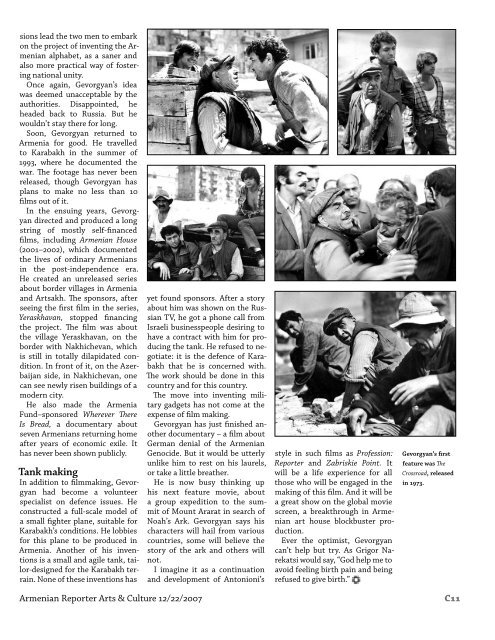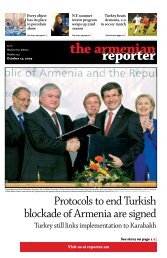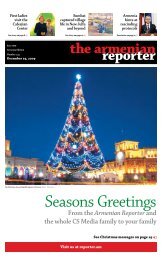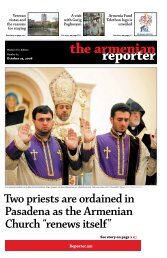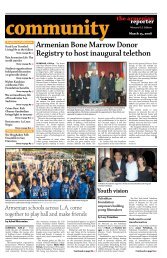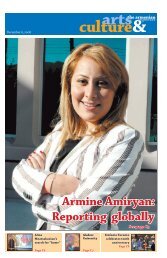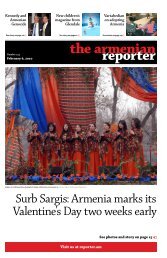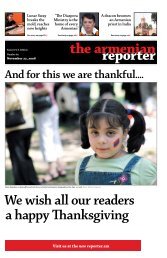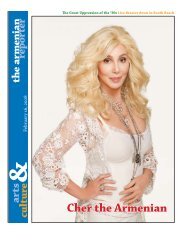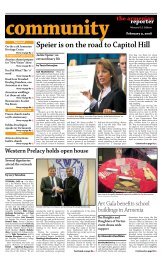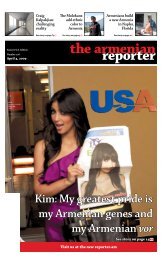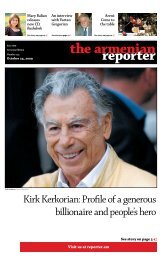Mihran's Mafia Style - Armenian Reporter
Mihran's Mafia Style - Armenian Reporter
Mihran's Mafia Style - Armenian Reporter
Create successful ePaper yourself
Turn your PDF publications into a flip-book with our unique Google optimized e-Paper software.
sions lead the two men to embark<br />
on the project of inventing the <strong>Armenian</strong><br />
alphabet, as a saner and<br />
also more practical way of fostering<br />
national unity.<br />
Once again, Gevorgyan’s idea<br />
was deemed unacceptable by the<br />
authorities. Disappointed, he<br />
headed back to Russia. But he<br />
wouldn’t stay there for long.<br />
Soon, Gevorgyan returned to<br />
Armenia for good. He travelled<br />
to Karabakh in the summer of<br />
1993, where he documented the<br />
war. The footage has never been<br />
released, though Gevorgyan has<br />
plans to make no less than 10<br />
films out of it.<br />
In the ensuing years, Gevorgyan<br />
directed and produced a long<br />
string of mostly self-financed<br />
films, including <strong>Armenian</strong> House<br />
(2001–2002), which documented<br />
the lives of ordinary <strong>Armenian</strong>s<br />
in the post-independence era.<br />
He created an unreleased series<br />
about border villages in Armenia<br />
and Artsakh. The sponsors, after<br />
seeing the first film in the series,<br />
Yeraskhavan, stopped financing<br />
the project. The film was about<br />
the village Yeraskhavan, on the<br />
border with Nakhichevan, which<br />
is still in totally dilapidated condition.<br />
In front of it, on the Azerbaijan<br />
side, in Nakhichevan, one<br />
can see newly risen buildings of a<br />
modern city.<br />
He also made the Armenia<br />
Fund–sponsored Wherever There<br />
Is Bread, a documentary about<br />
seven <strong>Armenian</strong>s returning home<br />
after years of economic exile. It<br />
has never been shown publicly.<br />
Tank making<br />
In addition to filmmaking, Gevorgyan<br />
had become a volunteer<br />
specialist on defence issues. He<br />
constructed a full-scale model of<br />
a small fighter plane, suitable for<br />
Karabakh’s conditions. He lobbies<br />
for this plane to be produced in<br />
Armenia. Another of his inventions<br />
is a small and agile tank, tailor-designed<br />
for the Karabakh terrain.<br />
None of these inventions has<br />
yet found sponsors. After a story<br />
about him was shown on the Russian<br />
TV, he got a phone call from<br />
Israeli businesspeople desiring to<br />
have a contract with him for producing<br />
the tank. He refused to negotiate:<br />
it is the defence of Karabakh<br />
that he is concerned with.<br />
The work should be done in this<br />
country and for this country.<br />
The move into inventing military<br />
gadgets has not come at the<br />
expense of film making.<br />
Gevorgyan has just finished another<br />
documentary – a film about<br />
German denial of the <strong>Armenian</strong><br />
Genocide. But it would be utterly<br />
unlike him to rest on his laurels,<br />
or take a little breather.<br />
He is now busy thinking up<br />
his next feature movie, about<br />
a group expedition to the summit<br />
of Mount Ararat in search of<br />
Noah’s Ark. Gevorgyan says his<br />
characters will hail from various<br />
countries, some will believe the<br />
story of the ark and others will<br />
not.<br />
I imagine it as a continuation<br />
and development of Antonioni’s<br />
style in such films as Profession:<br />
<strong>Reporter</strong> and Zabriskie Point. It<br />
will be a life experience for all<br />
those who will be engaged in the<br />
making of this film. And it will be<br />
a great show on the global movie<br />
screen, a breakthrough in <strong>Armenian</strong><br />
art house blockbuster production.<br />
Ever the optimist, Gevorgyan<br />
can’t help but try. As Grigor Narekatsi<br />
would say, “God help me to<br />
avoid feeling birth pain and being<br />
refused to give birth.” f<br />
Gevorgyan’s first<br />
feature was The<br />
Crossroad, released<br />
in 1973.<br />
<strong>Armenian</strong> <strong>Reporter</strong> Arts & Culture 12/22/2007<br />
C11


